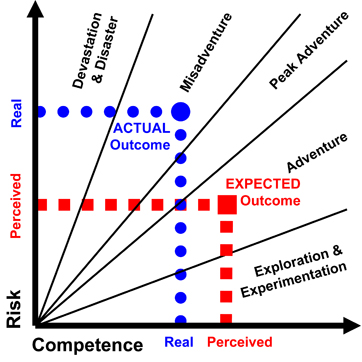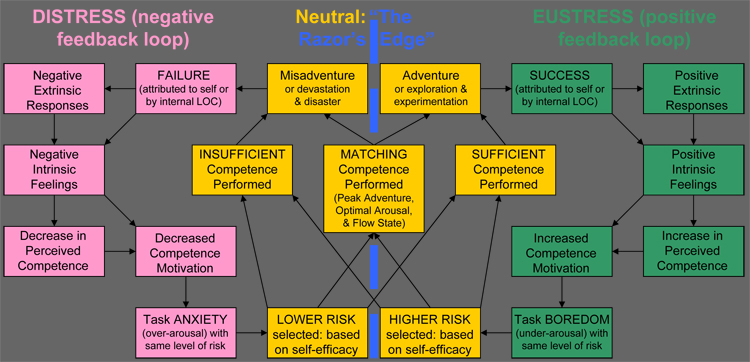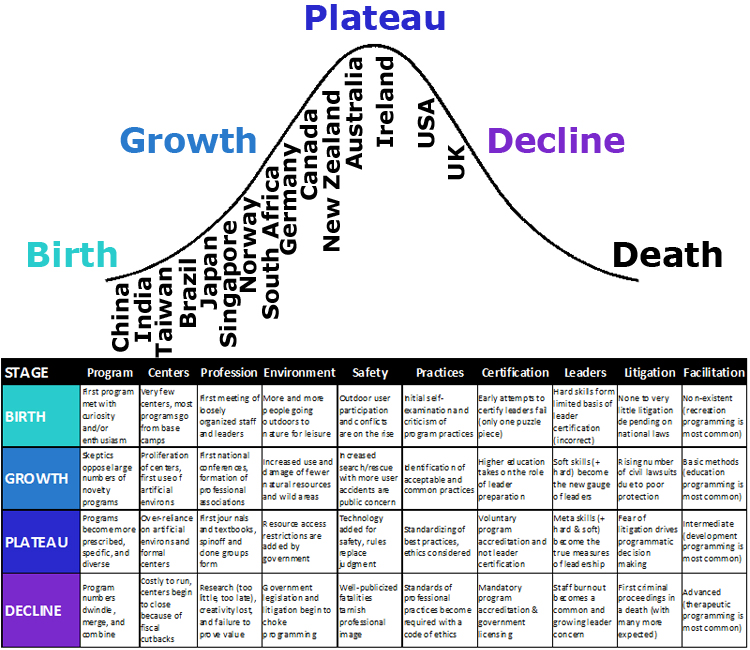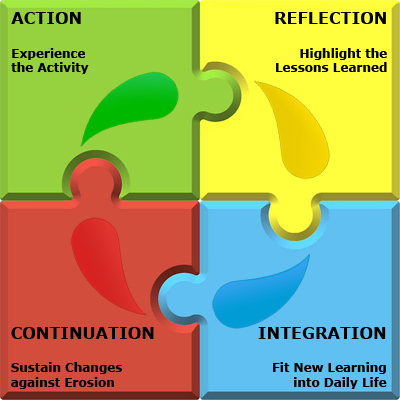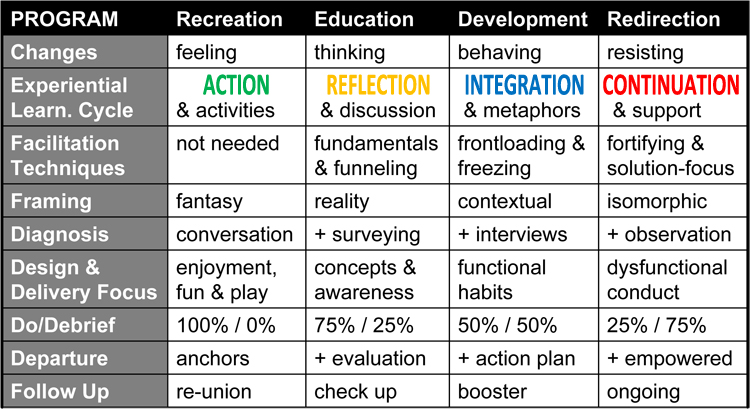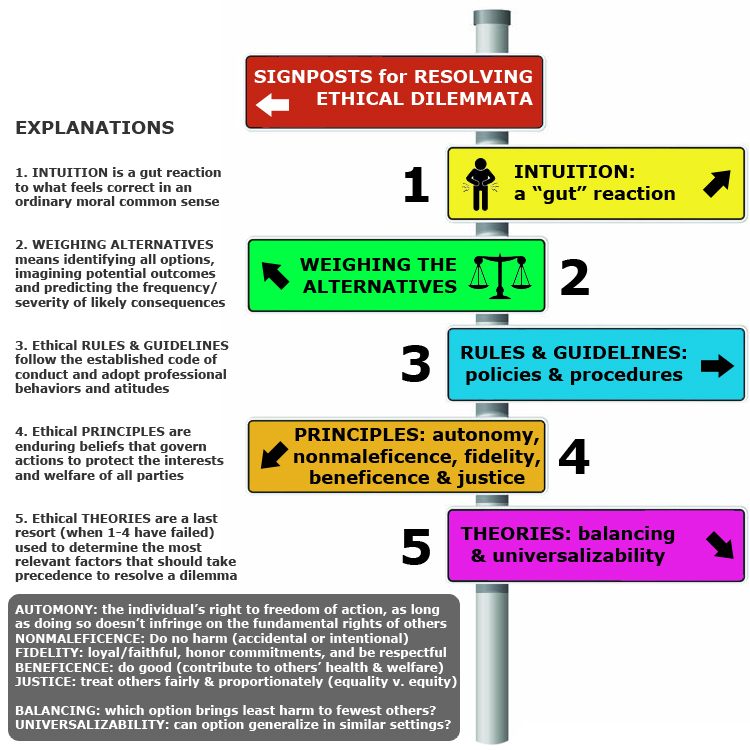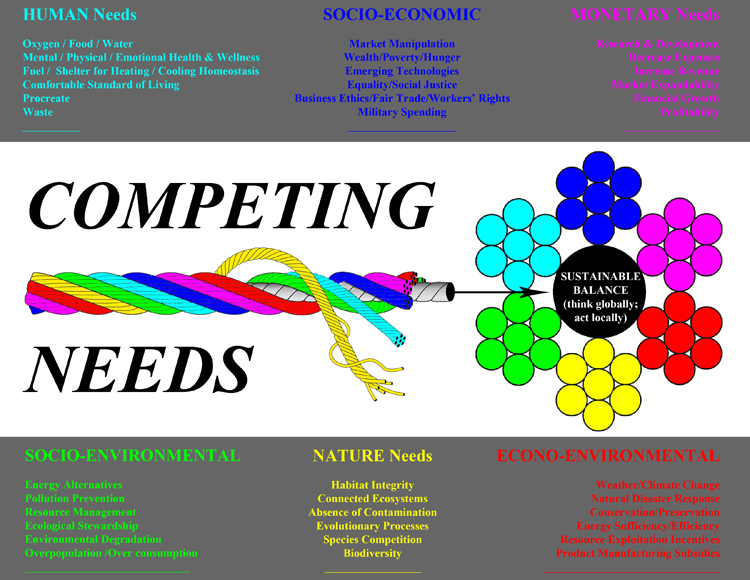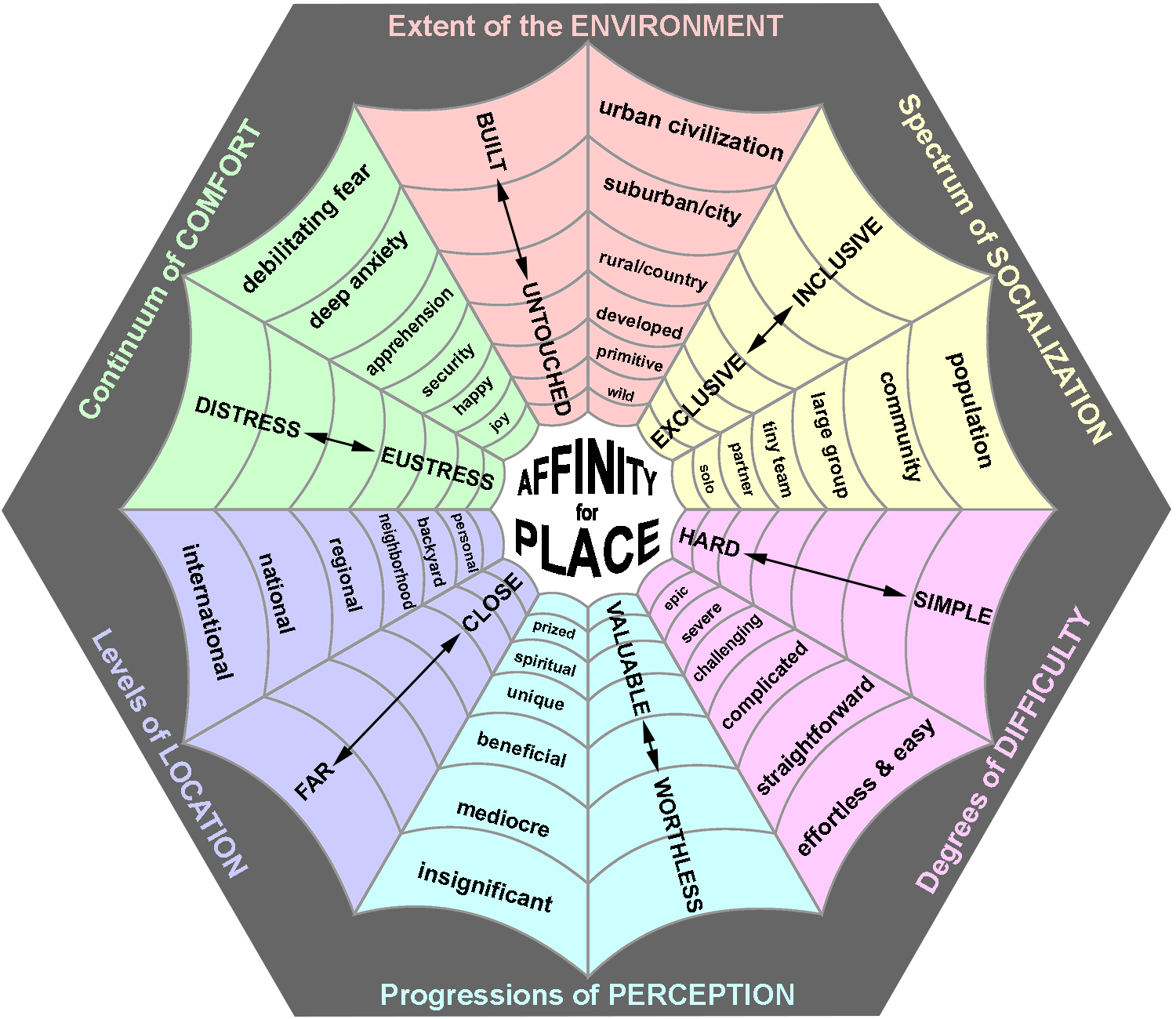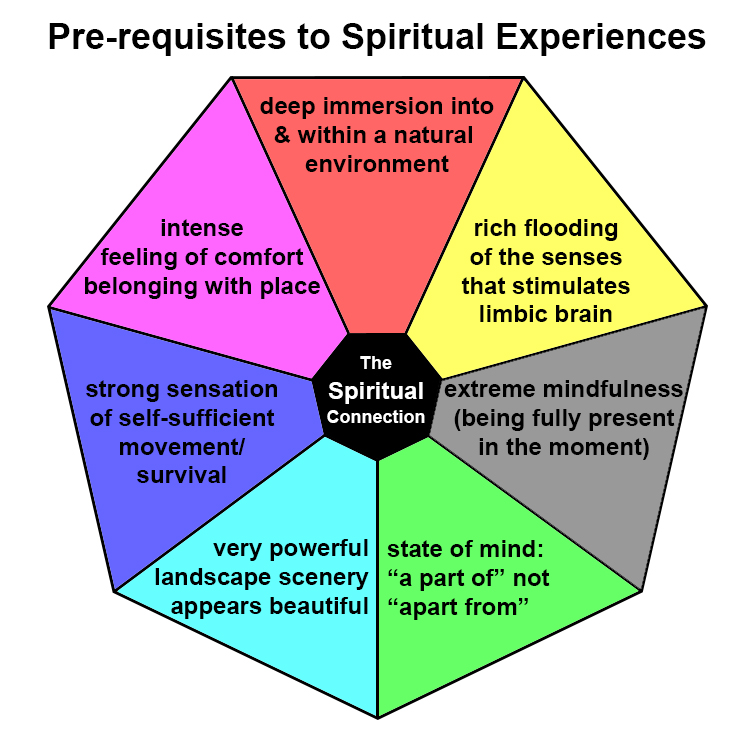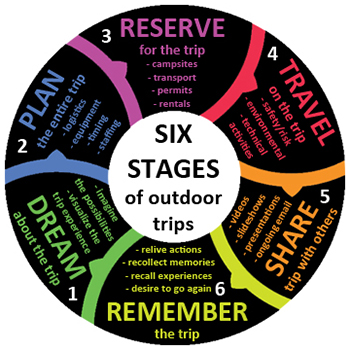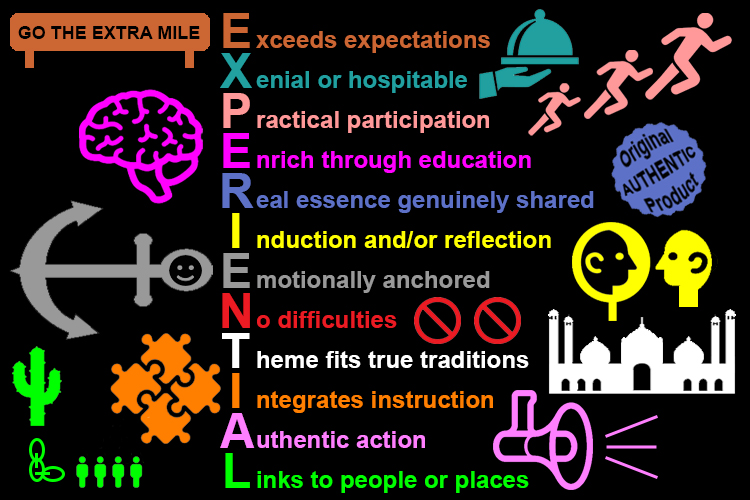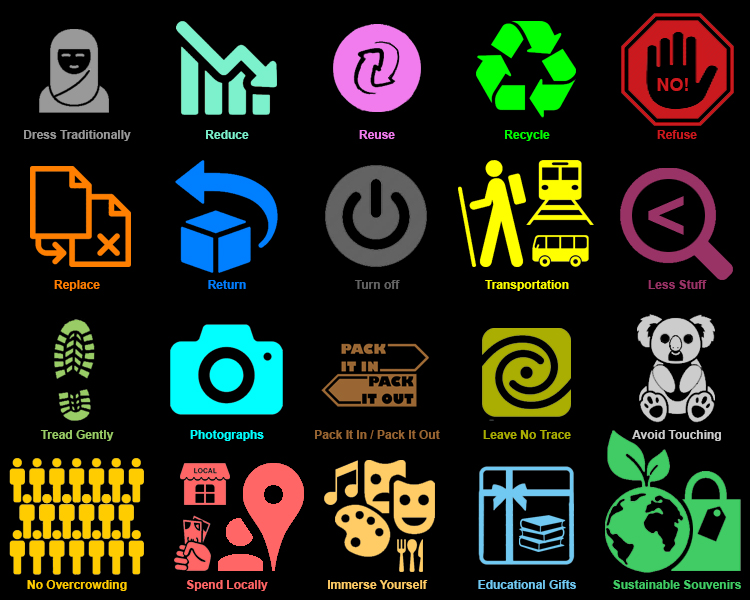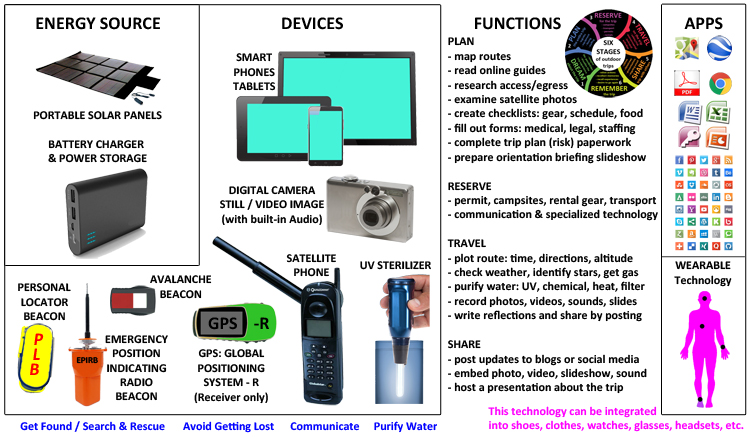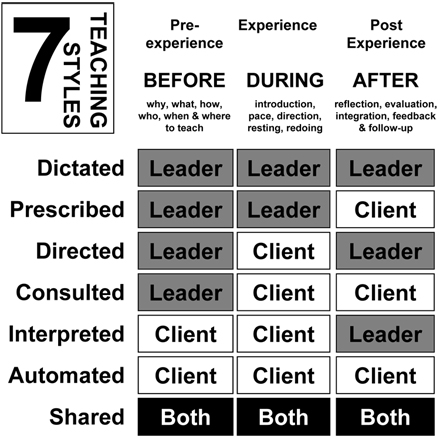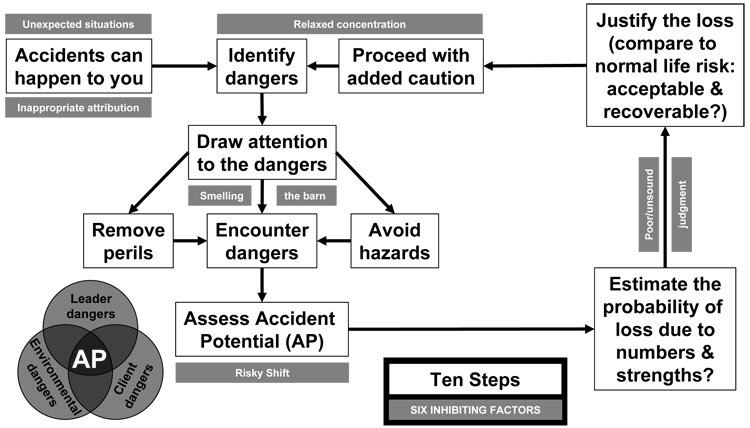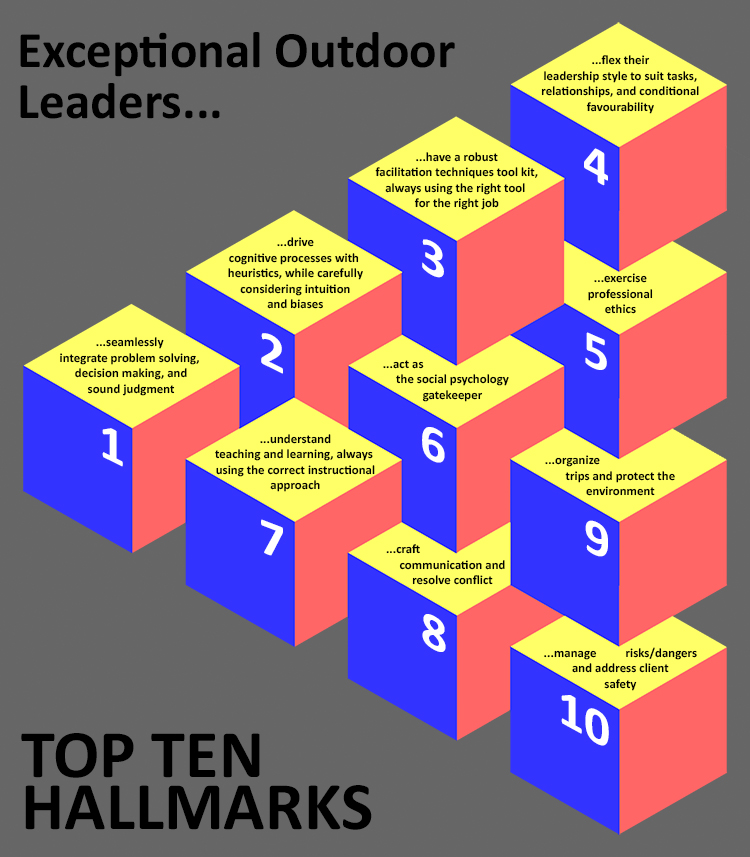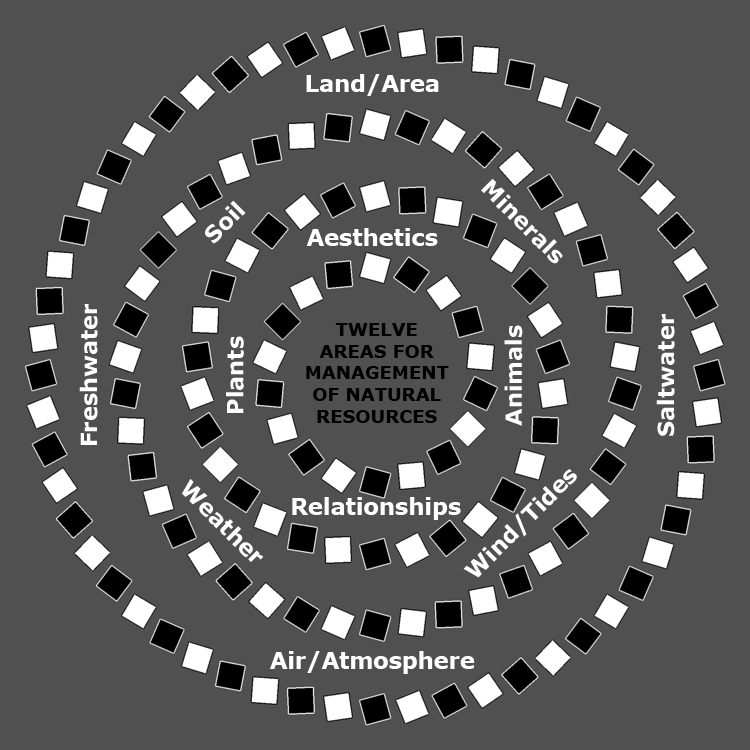
|
THE OUTDOOR TREE OF MANY RELATIONSHIPS: In 1984, I went to study with Phyllis Ford at the University of Oregon, but she left for another position shortly after I arrived. The good news was that I got to teach her graduate courses; the bad news was that I had no one to mentor my work. I was guided by Dean Celeste Ulrich toward a unifying philosophy of Outdoor Education (OE). The common definition then was Ford's: "learning in, for, and about the outdoors." However, OE had no uniquely identifying subject matter and appeared to be in conflict with itself with adventurers damaging the environment. As a result, OE was too easily dismissed as a potential teaching method for learning in schools and colleges.
I began to redefine OE and came up with the metaphor of a fruit bearing tree. Outdoor Education is a tree with two branches growing from a common trunk: Adventure Education (AE) and Environmental Education (EE). Both AE and EE use nature to teach about relationships. AE learning is mostly intrapersonal (understanding oneself) and/or intrapersonal (relating to others). EE learning is mostly ecosystemic (components interact in networked ecology) and/or ekistic (humans impact the quality of nature and this impacts the quality of their lives). When all 4 relationships are learned, teaching a fifth becomes possible: the spiritual (knowing one's place in the global scheme of change). Learning in all instances is driven by the engine of experiential education: a philosophy and method of teaching that is fueled by the energy of an outdoor setting. OE is firmly rooted (through six senses and three domains) in the nutrients of an interdisciplinary curriculum. When OE flowers and bears fruit, the result is people who know themselves and/or others, understand reciprocity in nature, comprehend their kinship role for the planet, and take action to make a difference. |
|
THE ADVENTURE EXPERIENCE PARADIGM AEP: While working on my doctorate, I met an Australian masters student named Peter Martin and we became fast friends. While taking a social psychology grad course together (taught andragogically by Gaylene Carpenter), we combined the play ideas of Ellis and Mortlock with Csikszentmihalyi's flow research and this graph resulted in 1985.
Risk is the potential to lose something of value, while competence is the collection of skills and abilities that are applied against risk to result in a positive outcome. With inaccurate perceptions of risk and competence (in red), one might expect only an adventure. However, since real values for both are different (in blue), a minor misadventure results. Through guided reflection (see next model) and repeated attempts, perceptions come in line with reality. The result is an astute adventurer: a person with accurate risk and competence perceptions.
While we initially developed the AEP for the outdoors, it has enjoyed a widespread application to financial risk taking in business and gambling as adult play. |
|
COMPETENCE EFFECTANCE IN RISK TAKING: While both working on our doctorates separately in differing fields in 1986, my partner and I merged the works of White (Effectance Motivation) and Harter (Competence Motivation) in an effort to describe human motivation and risk taking behavior. This rather complex model, partially confirmed by linear structural relations and path analysis, has 3 parts: positive, neutral, and negative.
The positive is an upward corkscrew that can lead to greater risk taking, while the negative route is a downward spiral that leads to lesser risk taking. The Razor's Edge is in the middle of the neutral part. This is the imaginary thin line that risk takers attempt to stay atop for the feelings they get.
|
|
OVERCOMING FEAR (& ANXIETY): My mother was the most amazingly competent and strong woman. As a young boy, I watched her care for my younger sister, myself, and her dying mother, all while simultaneously graduating top ten in her medical school. As I grew up, I learned from her about what competence meant as both caregiver and professional. She became my model for what a strong woman should be, even up until her retirement from surgery at 75 years of age. As she now nears the end of her life, I am reminded of her dignity, sharp intellect, and ministering to the sick and injured, even when she was ill.
Mum has one debilitating fear. She is afraid of spiders. This is a fear that many people share and I have been aware of my own, when these critters jump or move unbelievably fast. I soothed myself with the past belief that my reaction was a reflexive response designed to keep humans alive in prehistoric times. I also thought about Bandura’s self-efficacy theory. His initial research was with fear of snakes. He wanted to know how subjects would gauge their certainty of completing a progression of tasks from observing, touching, and holding snake photos to observing, touching, and holding live snakes. I recall teaching my Texas A&M students about self-efficacy by bringing a Tarantula to class. They were initially encouraged to deal with photos and then to eventually observe, touch, and hold the giant furry spider. Lucky for me, I could facilitate this immersion therapy, only because the Tarantula moved very slowly!
In the years that followed, I deliberately placed clients and students in dangerous risk taking situations for a wide variety of interpersonal and intrapersonal purposes. Among a plethora of outcomes, these experiences also reduced their fears like no other form of therapy and this fear reduction transferred into new found confidence in other areas of their lives. These therapeutic methodologies worked for rational fears (based in truth, logic, or reason, like fear of public speaking justified by potential social embarrassment) and irrational fears (without truth, logic, or reason, like fear of clowns or coulrophobia).
Why is overcoming fear important? Since humans fear change, managing fear is an initial step to bring change into your life. Failure to deal with fear locks you into quiet desperation, where you grow to be afraid of more things. The more you try to hide your fears, the stronger and more diverse they become. However, sharing and expressing that you are scared sometimes takes away the power fear has and reduces the anxiety it fosters.
So how do we overcome fears? In my experience, a combination of three approaches works best. All three depend on the initial step of acceptance that is at the heart of each, followed by two steps for each of the three pairs. The diagram below shows three pairs of 5-cube U-shapes interlocked around a single 7-cube 3D hexalog cross that is at the center of the assembled shape. The center represents supporting acceptance, while the other shapes represent the first and second steps of the three paired processes for overcoming fear.
- ACCEPTANCE: It’s okay to be scared; fear is a natural human reaction. Recognize that you are afraid. Acknowledge your feelings, thoughts and actions that accompany fear. Identify sources of your fear or anxiety. Describe sources, feelings, thoughts and actions to disempower or diminish fears and anxieties. Imagine worst and best scenarios. Sequence your fears into a progression from minor to major.
- Desensitization A: Tackle your progression of fearful situations a little bit at a time, but you can stop at any point.
- Desensitization B: Before each new fearful situation, practice relaxation or another coping mechanism and do not proceed to the next level until you are fully comfortable doing so.
- Imitation A: Observe the successful fear management strategies of others and identify their model behaviors.
- Imitation B: Continue by applying their model behaviors, practicing observed strategies, and modifying as necessary, until you are comfortable with all situations and the fear has evaporated.
- Flooding A: Once you have a successful coping tactic, deliberately expose yourself to a maximum fear beyond your self-imagined limit, but make sure you can always back off
- Flooding B: Utilize your learned coping strategies and endure for a few minutes (after which the physiological response to fear weakens), until you begin to feel comfortable with your situation.
During these processes, relaxation techniques are a critical component of success. Finding the means to calm yourself down, a method that works well for you, is the best way to become aware that your fears may be unwarranted. Beyond this, other methods may include: questioning reality, distracting yourself, identifying fear’s foundations, reciting positive affirmations, concentrating on love instead, setting goals, taking a break, breathing, exercising, and making opportunity lists that can be realized from facing your fears. Finally, ask a friend to monitor your progress and act as a sounding board for your reflections.
|
|
INTERNATIONAL GROWTH CURVES: In 1993, I was asked to present my view of the future for Outdoor Education and Experiential Learning. My presentation was bleak and controversial, because I saw the profession dying with a clear need to reinvent itself. In the presentation, I identified ten indicator hallmarks that I had seen occur in several nations. I used these like a rubric to chart the location of the central tendancies for many visited countries on a typical growth curve. This version shows positions in 1993 with the assumption that each nation may have moved forward since then and several other countries have since entered the fray. |
|
THE EXPERIENTIAL LEARNING CYCLE: Many of these existed in 1990's, but few clearly explained both the learning and the guidance of learners. Mike Gass and I created this cycle in 1992 to address both.
- ACTION: experience the activity
- REFLECTION: highlight the lessons learned
- INTEGRATION: fit new learning into daily life
- CONTINUATION: sustain changes against erosion
After people participate in an activity, they reflect on their experiences so as to highlight the lessons learned. This new learning is integrated into their work, school or family life, and they make a change that is sustained in the face of strong erosive forces. If not carefully counteracted, the forces (lack of resources, old hurdles, peer pressure, etc.) tend to revert a person back to square one. |
|
THE FOUR PURPOSES OF ADVENTURE PROGRAMS: As young professors in 1992, Mike Gass and I (with help from Lee Gillis) were struck by the seemingly discrepant uses of experiential programming and so we divided program purpose into 4 types that highlight the very practical differences for each intent. The table summarizes the key differences arranged by the 5 ordered phases of program development. |
|
ETHICAL SELF-EXAMINATION: Around 2015, Mike Gass and I developed this continuum for determining where leaders stand on any issue and the strength of their stances. This is important as an initial step toward knowing your non-negotiable values and how your particular position is located with respect to those of your customers, clients, and profession. This knowledge permits you to comprehend your degree of neutrality and objectivity as you work with different groups. |
|
RESOLVING ETHICAL DILEMMATA: Dilemmata (plural of dilemma) are choices to be made among multiple alternatives, where no single selection is the favorable preference and all options are apparently undesirable. This happens often in life and I use this approach to reach resolution in those dilemmatic times. However, when conducting research with humans or animals (in whole as subjects or in part as tissue samples), I have the additional responsibility of ensuring that my chosen methodology does not harm them.
While the decision making and problem solving processes are familiar (see multiphasic methods), these five approaches inform one’s judgment, when drawing on previous experience is unavailable, by providing data for the unknown in times of uncertainty. By definition, a dilemma is rife with uncertainty and the unknown. Thanks to Mike Gass and Jasper Hunt for their clarifying time spent chatting about ethics as adapted from Kitchener’s (1984) model of moral reasoning.
The approach takes the form of signposts. I like this metaphor because, on those rare occasions where I have been lost while route finding in uncharted territory with map and compass or modern technology, I am thrilled to discover a sign on a post that points me in the direction I want to go! For me the signposts are, at best, salvation from disaster or devastation and, at worst, reinforcement for what I already know in my heart or mind to be true. Signposts offer a series of steps arranged in sequence and, most of the time, resolution can be reached by only considering their first few signs. However, in a more complex dilemma, the last few signs become necessary and are thought provoking and reinforcing.
Basically, these five steps are shown and described below. I follow them in sequence and, when resolution becomes obvious, I stop at that point. However, sometimes, I go all the way to the end to reach resolution, where the compromising choices are more about whom or what gets harmed the least and whether I could defend making the same choices in similar situations. I have always passed these five approaches on to my research students and other faculty. I hope they have found them useful. |
|
ENVIRONMENTAL SUSTAINABILITY: Back in 1981, I was very concerned that environmental sustainability was a sufficiently important topic and yet most people only approached it from their own personal perspectives. These were usually a combination of three primary and three secondary viewpoints.
- HUMAN needs (sociological)
- NATURE needs (environmental)
- MONETARY needs (economic)
- socio-economic (human & monetary)
- socio-environmental (human & nature)
- econo-environmental (nature & monetary)
In an effort to help everyone visualize and understand the perspectives of one another, I created this model based on intertwined wire rope. Half a dozen sample needs are listed under each perspective with room for a 7th. Sustainability means balancing all of these sometimes competing needs. Thanks to my undergraduate environmental education professor, Milt McClaren, who helped clarify my thinking. |
|
THE LADDER OF ENVIRONMENTAL LEARNING: The same year (1984) that I was figuring out the tree at the top of this page, I pondered what was required for a person to take action for change and came up with these steps arranged on a ladder (which I promptly stood up against the tree to pick its fruit). The nine steps on the ladder are organized into three phases: receptivity, recognition, and response. In receptivity, the students must have opportunity, interest and ability to learn about a setting. In recognition, they should generate awareness, gain appreciation, and understand the issues. In response, they ought to develop empathy (through spiritual relationships), take ethical action (no eco-terrorism), and evaluate whether or not they made a difference. |
|
S.T.E.A.M. EDUCATION: I was first introduced to this approach as SMET in the late 1990’s, as an outgrowth of experiential and outdoor education, especially where it was focused on the environment. The recent addition of Arts to STEM (Science, Technology, Engineering and Mathematics) gave us the modern STEAM movement. In my opinion, the degree to which art is included can be controversial to some, should be at the discretion of the instructor, and will range from minimal influence on design to maximal inspiration for creativity. When asked to explain this American originated curriculum approach to overseas audiences, I have enlisted the metaphor of a steam kettle as shown in the diagram below.
The kettle represents the constraining environment for learning. It must be constructed with four key elements. First and second, design thinking (creative synthesis as opposed to logical analysis) must be used in balance with a cycle of scientific inquiry (procedures used to investigate phenomena). STEAM is the subject matter of inquiry for both and can be represented by the surrounding atmosphere in this scenario. Third, STEAM learning activities must be delivered within an experiential philosophy and by experiential methods. Action alone is insufficient; this must be followed by reflection, integration, and continuation. Fourth, those STEAM activities (whether project-based or problem-based) must be framed around real world projects and problems that provide hands-on opportunities to act and learn.
The heat source applied to the kettle represents the teacher’s role to facilitate discussions, guide inquiry or critique, and mentor innovation. These three pedagogical approaches (very different from presenting lectures) are the energy that motivates and supports learners as they learn from doing STEAM activities. The water inside the kettle represents the learners’ roles along with their potential for growth. They should muster their curiosity and imagination, bring their critical and creative thinking skills, and seek to improve and invent as they solve the problems and complete the projects presented to them.
As the heat “energizes” the water, steam is produced from the kettle. Steam represents the growth or achievement of individual learning objectives from the potential each learner brings to the activities. Students, working on problems or projects by participating in a STEAM Education program, will learn to:
- Explore and scrutinize alternatives,
- Combine ideas and attempt multiple ideas,
- Willingly take risks,
- Recover from any failures,
- Grow from reflection on those setbacks,
- Listen to other in order to understand and collaborate,
- Welcome diversity of opinion and embrace change as normal,
- Be prepared for a future society (not the present one), and
- Have fun.
While the greater good goals of a STEAM Education program may be to increase the engagement of women, minorities, or indigenous citizens, and to graduate an increasing number of employees for the workforce, its preparation more importantly represents a shift away from learning to take standardized tests and toward learning for life and future living. Therefore, it should not be implemented with the typical hallmarks of schools, such as right or wrong answers and bell-signaled precise learning periods. |
|
DEVELOPING AN AFFINITY FOR PLACE: Place is critical to outdoor and experiential forms of learning. Historically, the environmental branch (see tree at top of page) has focused on the importance of place. However, in the past decade, the adventure branch (previously about activities) has begun considering the importance of place as well. As I argued in 1986 (with the tree model at the top of this page), if learners develop their intrapersonal and interpersonal relationships (adventure), in concert with their ecosystemic and ekistic relationships (environmental), and blend both approaches into the same experience, then the fifth relationship of a spiritual connection to place becomes possible. I called this truly functional learning.
Once obtained, this kinship with nature connects us to a special place with such affinity that we are willing to take action to protect it (see the ladder above). At its most extreme, some of us were willing to “risk life or limb” for the cause. Witness those activists who chained themselves high up in trees to save a forest or laid down in front of machinery to prevent road construction into wild areas. Activists in Brazil and Cambodia had been murdered for speaking out against deforestation in their countries.
I wondered aloud in the late 1980s, what is it about our connection to place that makes us willing to offer our life in defense of natural resources? In answering, I envisioned what it might take to develop a kinship sense with a place in the outdoors and/or through experiential learning and decided some of the extremes for six factors were necessary to easily develop a widespread affinity. The learners must be: joyfully comfortable after having survived an epic journey, concentrating on personal concerns, and reflecting on the value of a wild environment while completely alone. Once affinity was created, those learners were able to handle additional discomfort, appreciate much easier tasks, manage greater sized socializations, consider global concerns, see the value in all places, and welcome civilization on return to their cities. Nevertheless, connected learners often felt a profound sense of loss upon departing the place. Here are the six factors with greater explanation.
- Continuum of COMFORT ranges from fear to joy. If learners are afraid, they cannot connect with the place and will only dread it. They must first learn to exist joyfully in a new place, so they learn to control their fears. Once they are having fun, their comfort level breeds affinity.
- Degrees of DIFFICULTY range from effortless to epic. Nothing worth learning was ever achieved easily or without effort. Completing an ambitious journey in place allows learners to develop self-confidence that they can then use to make a difference in that place and in other places.
- Spectrum of SOCIALIZATION ranges from population to solo. We are rarely alone in society and solitude is required for deep contemplation and mindful reflection. Learners must take unaccompanied time to think about the place, their role within it, and the connection of both.
- Levels of LOCATION range from personal space to global context. By connecting the personal through exercise and activity, learners are able to physically engage and sensorily immerse themselves in a place. This leads to enhanced awareness, appreciation, and understanding as they come to accept changes in nearby locations and make changes in more distant ones.
- Progressions of PERCEPTION range from insignificant to prized. How learners perceived a place depends on combining the other five factors with a qualitative interpretation of the place’s soul, beauty, utility, purity, authenticity, essence, freedom, and potential to move them emotionally.
- Extent of the ENVIRONMENT ranges from civilized to wild. Through exposure to the purest of places, learners can understand the extent of what is possible when humans have not yet impacted a place. This leads to a desire to protect the place and restore other damaged places.
I suggest that learners who possess an extreme position in one or more of these factors can become closely linked to place. Furthermore, a deficiency in one factor can be enhanced by possessing two or more extreme positions in the other factors. Learners who have reached an affinity or kinship with the place are able to take action in other places. Despite lacking some factors in those other places, learners can compensate by drawing on memories of extreme positions for the original place. Affinity transfers. |
|
FRILUFTSLIV AND THE SIPRITUAL RELATIONSHIP: Norwegians have an indigenous Scandinavian way of life that is called Friluftsliv (pronounced “free-loofts-leave”). It translates to English in several ways.
- fri = free
- luft = air
- friluft = recreation
- frilufts = open air
- liv = life, living
- friluftsliv = outdoors
Coined in 1859 by Henrik Ibsen, in his poem, Paa Vidderne (On the Heights), the word literally means “open air living” or recreating outdoors. It involves exploring and appreciating nature in a non-impactful way of life. Friluftsliv is not an isolated concept. It forms an integrated ingredient of the collective Norwegian consciousness at a spiritual level. As I have often mentioned in the past (see the tree at the top of this page), potentiating the spiritual relationship is possible once one has reached comfortable levels of understanding about the other four relationships: to oneself (intrapersonal), interaction with others (interpersonal), nature (ecosystemics), and the reciprocity between humans and nature (ekistics).
The spiritual relationship figures prominently in Friluftsliv and is very difficult to convey to someone who has not already experienced a special affinity with nature. By the early 1990s, I had identified that my own spiritual relationships usually had these seven prerequisites in common.
- deep immersion into and within a natural environment,
- intense feeling of comfort and belonging with that place,
- rich flooding of the senses that stimulates the limbic brain,
- strong sensation of self-sufficient movement and survival,
- extreme mindfulness: being fully present in the moment,
- very powerful landscape scenery that appears beautiful, and
- a state of mind that is “a part of” rather than “apart from”
When I experienced these seven (or sometimes when only a few were present), I made a spiritual connection with nature that rejuvenated my soul. This spiritual experience tied directly back to Friluftsliv.
Friluftsliv was the indigenous way of living that dated back to the times of fishing, hunting and gathering, when the population worked and lived outdoors with a spiritual connection to the land and water. The advent of farming meant an agrarian lifestyle: working outdoors, but living indoors, protected from the elements. As such, the spiritual connection to the outdoors was weakened. By the time of an industrial revolution, with a population who both worked and lived indoors, the connection was lost. As modern technology further rationalized Norwegian lifestyles, a sense of calm and balance seemed missing from their lives. Hence, the “getting back to nature” movement arose in the 1990s and Friluftsliv led the way.
Once the importance of Friluftsliv was understood, it was inculcated into employment and all levels of schooling. Many companies blocked out work time for employees to go outdoors and provided flexible work hours. Some held their meetings outdoors, while walking in nature. Others received tax breaks for sponsoring employee Friluftsliv and provided incentive rewards to those who walked, skied, or biked to work. Friluftsliv contained a definite physical factor and participants were expected to be active. The subject was placed in the physical education discipline, but was more than exercise. It also incorporated many elements of other subject areas including a strong component of environmental education.
In 1996, I taught at the Norwegian Sports University in Oslo and witnessed the resurgence of Friluftsliv as a means to get back to nature from lives spent in a city connected to technology. Two decades later, I write down these ideas after the United Nations (UN) published their World Happiness Report 2017 that ranked these countries as the top ten nations for their sense of healthy well-being:
- Norway
- Denmark
- Iceland
- Switzerland
- Finland
- Netherlands
- Canada
- New Zealand
- Australia
- Sweden
The USA ranked 14th and the United Kingdom ranked 19th on this list. However, the ten nations listed have been consistently in the top positions since the first UN report in 2012. Over time, Norway has risen to the apex from lower down on the top ten. The five Scandinavian countries on this list (Norway, Denmark, Iceland, Finland, and Sweden) are those that are most connected to an outdoor lifestyle. Each nation has its own version of Friluftsliv. I would further argue that the other five (Switzerland, Netherlands, Canada, New Zealand, and Australia) are also well connected to the outdoors, but in fewer numbers within their overall populations. My premise: a happy life is an outdoor life and vice versa. |
|
SIX STAGES OF OUTDOOR TRIPS: In 1995, I began an adventure travel and eco-tourism program at Brock University and hired Mike Strong to be the Coordinator. He provided some ideas to create these six stages of outdoor trips. The model informed our adventure travel and eco-tourism trips as well as our outdoor fields trips for the leadership program. The six stages were:
- DREAM about the possibilities and trip experience
- PLAN for logistics, equipment, timing, and staffing
- RESERVE the campsites, transport, permits, and rentals
- TRAVEL and monitor safety/risk, environment, and technical activity experiences
- SHARE through videos, slideshows, formal presentations, and informal emails to friends and family
- REMEMBER enough good to want to do it all over again!
Since then, technologies have revolutionized processes for the middle four stages. For example, sharing your trip experience with others has a whole new meaning with the advent of blogging and other forms of social media. |
|
SUSTAINABLE ECOTOURISM: When we started the adventure travel and ecotourism minor above, we had three guiding sustainability principles. Our trips had to be: low impact (conserving natural ecologies), locally sourced (benefitting nearby communities), and socially responsible (protecting cultural identities). Since then, I’ve spent a couple of decades as a world tourist and seen a lot of tourism that clearly isn’t sustainable. After going back to places five or ten years later, I saw how an influx of tourists had advanced the infrastructures, worn out the environments, devastated the local populations, and diminished their unique ethnicities. To communities rich in heritage, but poor in economy, the power of money and people’s greed had brought about a bold willingness to obtain wealth by changing quickly. This rapid transformation (they can’t go back to the way they were) results in erosion of the natural or cultural reasons for tourists to visit. They eventually stop coming and the community is left destitute. I am shocked by the number of amazing places that I visited in my youth that have repeated this cycle.
Clearly, to prevent this unprecedented consumption, all tourism should follow some best sustainability practices. Here is a checklist, organized around the word “ECOTOURISM,” that I have recommend to groups when advising on sustainable adventure travel or ecotourism projects that involved heritage resources such as biodiverse environments, unique species, areas of great beauty, archeological or historical sites, and exposure to ethnic traditions (arts and crafts, feasts, home stays, etc.).
- Economic = Involve local economic sponsors and surrounding communities in a cooperative process. Everyone is a stakeholder in the success of the project and competition should be avoided. Employ local workforce and discuss social justice issues (role of women, disabled, etc.). Establish equitable profit sharing. When setting prices, consider expenses and include costs of a carbon footprint.
- Classify = Identify and classify heritage resources (historical, ecological, anthropological, etc.). Measure and record their baseline levels of “unspoiled perfection” for later use in monitoring.
- Organize = Arrange the heritage resources by proximity to one another and organize these into tours of nearby groupings. Omit precious, distant, difficult or unreachable heritage resources.
- Transport = Determine the transport used to reach the resources (foot, bike, boat, bus, plane, etc.) Moving and managing masses of people can often cause adverse impacts. Eliminate their resulting waste accumulation (toilets, garbage, etc.) and reduce subsequent air, water, or land pollution.
- Outsource = Decide what goods (handicrafts, art, food, etc.) and/or services (transport, marketing, technology, management, etc.) to outsource. Where possible, use local providers for outsourcing.
- Understand = Know your clientele and understand their needs. Recognize that their reasons to visit may conflict with your reasons (economic stability, conservation, preservation, pride, etc.) to implement. Make certain your heritage resource interpretation is enjoyable, engaging, and experiential.
- Renew = Use renewable energy sources (solar, wind, wave, tidal, geothermal, etc.). As appropriate, renew, restore, and rehabilitate heritage resources to baseline levels of “unspoiled perfection.” Eliminate natural resource exploitation or extraction that might impact heritage resources (mining, forestry, etc.).
- Infrastructure = When necessary, construct infrastructure (roads, trails, buildings, ablutions, housing, runways, docks, etc.), but make each facility and access as least impactful as possible.
- Sustainability = While making decisions, always seek to balance competing sustainability needs. Create a sustainability mindset and an impact awareness within the contributing communities.
- Monitor = Regularly monitor impacts on the previously identified heritage resources. If the impact is not sustainable or recoverable, limit access or add restrictions, but continue to monitor.
|
|
SUSTAINABLE TOURISM SCALE: I started in the 1980s (at the University of Oregon) and finished in the 1990s (at Brock University) a ten-point scale for identifying and combining sustainability issues and actions in ecotourism settings. The scale included ten characteristics of sustainability patterned somewhat confusingly after the earlier advising checklist for ECOTOURISM:
- E liminate visitor waste and minimizing pollution to prevent impact,
- C onserve heritage resources and protecting against visitor damage,
- O ffer safe experiences to visitors with well managed risks and dangers,
- T ransport visitors in ways that protect against injury to resources,
- O utsource contracts and subcontracts to empower local communities,
- U se renewable energy sources for all program and facility needs,
- R estore tired and spolied heritage resources to prior baseline levels,
- I nvest profit back into the community and employing local workers,
- S ustain culture and traditions (especially when wealth is provided), and
- M onitor and frequently evaluate the program and its heritage resources.
Based on the number of characteristics satisfactorily revealed by a program, it would receive a corresponding score. My thanks go out to Dennis Howard and Larry Neale for giving feedback on the original model. Here is the improved proposal. This could be used to measure program efficacy and/or market sustainable programs. For programs that fall short of an ideal, it could be used as motivation to improve operations to a higher score.
- NONE (0): tourism program fails to show any sustainability.
- MINIMAL (1-2): presents one or two of the ten characteristics.
- MILD (3-4): expresses three or four of the characteristics.
- MODERATE (5-6): demonstrates five or six of the ten.
- EXEMPLARY (7-8): illustrates seven or eight of the characteristics.
- EXCEPTIONAL (9-10): exhibits all, or all but one, of the ten characteristics.
|
|
EXPERIENTIAL TOURISM: Around the turn of the last century, I noticed that the term “experiential” had been adopted by disciplines outside of education (its point of origin in the 1960s). I think this was happening because experiential educators couldn’t agree on their own use of the term for several decades and failed to establish it as being in their domain. Nevertheless, I was hearing a great deal about experiential marketing, experiential design, experiential psychology, and experiential tourism.
Like ecotourism, experiential tourism has had multiple interpretations in marketing slogans. I see it as travel experiences that are active, educational, conservation-oriented, novel, risky, or deserted, and not so passive, entertaining, consumption-oriented, familiar, safe, or crowded. Compare the singular tourist who lives, travels, learns, teaches, and exchanges gifts with an indigenous population with the mass of tourists who pass through, enjoy a feast, are entertained by a show, and then buy souvenirs from the gift shop on their way out. Both are different forms of tourism. I believe the former to be more experiential than the latter.
However, I further propose that experiential tourism has a unique purpose to grow, change and take action that makes a difference (as in the ladder above). Experiential travelers collect learning experiences and derive meaning from their direct and purposeful interaction with the touristic setting, its people, places, natures, and cultures. Personalized for each individual’s needs, experiential tourism is a reflection of their values and interests. It engages with them to provide authentic experiences which enlighten and generate awareness leading to change. They participate holistically (all senses, all domains) and immerse themselves in the culture and daily life of a community through traditional home stays or journeys.
The experiential traveler takes action that helps solve a problem, complete a task or project, and makes a big difference for communities, but may not be sustainable. Some volunteerism examples might include providing purified drinking water through “slingshot” vapor distillation technology systems, bringing drinking water by pipe and pump systems, and supplying water via newly built road systems. However, none of these three examples can be considered ecotourism or sustainable tourism, because each changed the isolationist nature of the community and thus transformed their traditional culture. Not having to spend large amounts of time securing potable water or wasting time dealing with illness from water borne pathogens, the people became free to do other things. With abundant spare time, they applied themselves to pursuits that ultimately changed their traditional culture. So the experiential traveler does not necessarily engage in ecotourism or environmentally, economically, or culturally sustainable tourism, unless the traveler has a responsibility interest in this direction.
I saw one consumer-oriented trip that included “experiential shopping” in the world’s largest mall. In an effort to attract customers, tourism programs seem to be adopting the term “experiential“ the way they once did “eco-” to mean economically or ecologically attractive packages. Since customers appear willing to pay a premium for experiences, especially ones that protect nature and culture, many hotels and vacations are being sold on this premise. By 2001, this list seemed to make sense for what we should be aiming for in EXPERIENTIAL tourism.
- E = Exceeds expectations of visitors; delivers above promise
- X = Xenial relations or extreme hospitality toward strangers
- P = Practical “hands-on” participation in the experience
- E = Enrichment through education or learning about nature and culture
- R = Real essence is genuinely shared and experience is bona fide not artificial
- I = Induction or mindful reflection to generalize lessons learned from experience
- E = Emotionally anchored by positive feelings such as joy, happiness, and love
- N = No difficulties: easy information access, provider contact, program purchase, and visit mobility
- T = Themed to fit with the true traditions and environs of the location
- I = Integrates instruction and learning into visitors’ daily lives
- A = Authentic action results from visitors’ learning experience
- L = Links to people or connects to places with significance and permanence
|
|
SUSTAINABLE TRAVEL GUIDELINES: Here is how I choose to travel. By no means do I have it perfected, but it seems to work well for me. Each of us can contribute to travelling responsibly by doing as much as we can of the following 20 guidelines updated from 2001. Definitely don’t ask providers to break any of these guidelines on your behalf, such as getting within minimum distance rules from animals or collecting specimens, especially when you see other operators letting their clients do this.
- Dress in traditional clothing to avoid offending (cover skin/hair and wear androgynous when and where appropriate)
- Reduce water usage: take shorter showers, not longer baths, and turn off faucets when not being used
- Reuse existing water bottles or refill personal ones (BPA-free) rather than throw out used plastic bottles
- Recycle as much as you can, especially by holding onto items until a suitable recycling location is found
- Refuse to buy food or other products with excessive packaging that is simply going to end up in a landfill
- Replace towels every few days rather than every day; get your room cleaned weekly rather than daily
- Return brochures and maps when read; take used soap or other amenities that will otherwise be tossed
- Turn off the lights, when not in that room; turn off TV, heat and/or air conditioning when leaving hotel
- Walk instead of drive, use public transit over private transport, and take the train rather than the plane
- Take and collect less stuff (fuel use is reduced by packing light and keeping your load under weight)
- Tread gently on the land (take nothing but photos, leave nothing but footprints, kill nothing but time)
- Ask permission to photograph and/or delete images when asked to do so (avoid stealing others’ souls)
- Pack out what you packed in, pick trash not flowers, stay on trails and avoid shortcutting switchbacks
- Leave no trace: travel and camp on durable surfaces, no fires, urinate and defecate conscientiously, etc.
- Avoid touching or feeding wildlife; these have a special diet, are not your pets, and suffer from attention
- Do not overcrowd in situations that threaten species and/or detract from other tourists’ experiences
- Spend locally: eat out and stay with those who will actually keep the money (not some foreign company)
- Immerse yourself in music, art, theatre, cuisine, and other cultural aspects to see life as the locals do
- If necessary to give gifts, make these educational (like books or school supplies, not candy or sodas)
- If absolutely necessary to buy souvenirs, ask what each is made from and how it is made: avoid materials that are not sustainable and/or processes that endanger species or nature and peoples or cultures
Beyond this, I learn at least four short phrases in the local language: hello, good bye, please and thank you. I eat vegetarian, not because I love animals, but because I hate plants! No, seriously, I avoid meat because most cattle produce methane that is a more impactful greenhouse gas than carbon dioxide. Going vegetarian (or even vegan) drastically reduces my carbon footprint. I make sensible choices and proactively pay carbon taxes. |
|
TECHNOLOGY IN THE OUTDOORS: Rarely have I gone outdoors without technology. In the early days, technology was more about changes to gear: plastic boots, internal pack frames, lightweight materials, advances in waterproofing, and fleece replacing wool! Today, technology is synonymous with computing. I can remember the debate about how taking a cell/mobile phone would change the perception of wilderness and it did.
The diagram below outlines the need for an energy source, the variety of devices in use, their functions (as per the above middle four stages of outdoor trips), and the applications used to perform those functions. Of course, wearable technology is changing the game even further. Nowadays, I take most of this technology with me when I go outdoors, but then I am a technophile. |
|
SEVEN TEACHING STYLES: In 1997, Mike Gass and I developed this model of seven teaching styles built on sound philosophy from well established physical education pedagogy. The learning experience is divided into three phases: before, during, and after. The choices in these phases can be made by the leader or client. The seven styles are simply different combinations of who makes the decisions at each of the phases. The phases can be broken down as follows:
- BEFORE (Pre-experience): WHY (reasons to learn, uses of lessons, depth of information, relevance to client), WHAT (subject matter, intended objectives, expected outcomes, required resources, evaluation methods), HOW (methods, techniques, feedback, evalaution), WHO (clients, groups), WHERE (setting, positioning), & WHEN (scheduling, sequencing).
- DURING (Experience): INTRODUCTION (briefing, framing,), PACE (rhythm, speed), DIRECTION (adjustments), RESTING (breaks, teachable moments), & REDOING (repeat to perfect).
- AFTER (Post Experience): REFLECTION (gaining meaning facilitation), EVALUATION (criteria, procedures), INTEGRATION (links to life), FEEDBACK (verbal, non-verbal, source, delay, withhold), & FOLLOW-UP (enhance transfer, alternatives).
|
|
THE LEARNING GRADIENT: Don Hammerman and I came up with this gradient in 1990. I never thought much of it, but since Bob Stremba remarked that this really resonates with his students, I have added it here. Basically, the retention of information increases as the instructor moves from telling, through showing, to doing, withasking questions to confirm and cement learning. Three types of useful questions are recall, process, and application. |
|
|
SIX PHILOSOPHY QUESTIONS: A few years ago, Mike Gass and I were rewriting chapters for a new edition of one textbook when we settled on these questions to explain how the six branches of philosophy (the study of wisdom seeking the real truth of the human condition) intersect with our profession. This chart explains the connections with some sample questions. |
|
RISK MANAGEMENT ANALYSIS: While working with Rusty Baillie and Bill March to identify the "real razor's edge" in 1987, we talked a lot about the order of tasks associated with analyzing and managing risks. Following our discussions, I came up with this sequence of ten steps and six inhibiting factors at each step. |
|
CRISIS MANAGEMENT: Building on the work of Yvars and of Leemon, Mike Gass and I adapted this 2016 organizational chart showing the roles, relationships, and responsibilities of people who respond to a major crisis, like a lost client or unfortunate fatality during a program. Our adaptation is composed of the FIELD STAFF (who have notified the administration and become “the front line” response to any incident), an appointed INCIDENT DIRECTOR (who oversees the emergency response and networks with others to provide assistance), and eight additional functions. These extra eight functions typically include maintaining program continuity, documenting actions taken, coordinating responses in the field, evacuating the injured, notifying their families, communicating with the media, investigating after the fact, and conferring with legal counsel. We recommend 4-8 people take on these eight additional roles. Functions can be paired as shown in the org chart. |
|
OUTDOOR LEADERSHIP CURRICULUM: Most American universities conduct a Master’s degree (without research) by stringing together 30 credits of relevant courses. At Canadian and Australian universities this might not be sufficient for a graduate degree (it would need a research thesis adding to the mix along with some research and statistics courses) and would therefore be more likely offered as a post-baccalaureate degree. At any rate, this recommended sequence and content of ten (10) 3-credit courses stems from my Master’s and Doctoral studies conducted in the 1980s. Completed over a one year period (summer to summer), it involves three summer courses at the beginning, and three summer courses at the end, with four courses taken during the time in between (fall, winter and/or spring semesters). This model is particularly attractive to school teachers who tend to gain a pay increase with the completion of a graduate degree. If this curriculum is offered as a minor concentration or part of an undergraduate major, then the courses could be spread out over two years (third and fourth years).
As a warning, this subject matter cannot be taught entirely in the classroom; it must include plenty of field experiences with ample reflection. Teaching outdoor leadership without practical applications is like teaching a pilot to fly a plane without simulator training or flight time. As a faculty member, do not allow an institution to put you in the position of teaching a course you are not trained to instruct or encourage you to indoor teach an outdoor course! Consequently, the most appropriate students, to enroll in a program like this, are ones with extensive and intensive practical experience in at least two or three technical activities like backpacking, paddling, climbing, or skiing. In my experience, degree granting institutions waste a lot of time teaching the hard skills to their students and ignoring the soft and meta skills of leadership. They certainly do a great job of producing outdoor recreationalists, but fail miserably to properly prepare the future leaders of adventure programs. Don’t forget that adventure programs are the only structured learning experiences that deliberately and purposefully place the learners in danger, so that they may benefit by forming and reinforcing highly functional interpersonal and intrapersonal behaviors or relationships. Its leadership should be highly competent.
- Foundations: An overview of the profession’s research, history, philosophy, social psychology, breadth & depth, and trends & issues (this is the only course that could be entirely conducted in a classroom, but still demands experiential methodology).
- Risk, Safety, and Environment 1: the participant responsibilities for managing risk, applying safety countermeasures, and protecting the environment.
- Technical Activities 1: actual land or water-based trip (3+ days) organized with an emphasis on planning and execution (students finishing their degrees take leadership coaching roles in this course, as part of “Flexible Leadership Style,” while students starting their degrees in this course rotate leader for a day; faculty still supervise all events).
- Judgments, Problems & Decisions: examination of factors, methods, and interference in creative decision making, multiphasic problem solving, heuristics, intuition and judgment (includes practical sessions to make decisions, solve problems, and apply judgment; faculty still supervise all events).
- Risk, Safety, and Environment 2: the outdoor leadership responsibilities for managing risk, applying safety countermeasures, responding to accidents, and interpreting the environment.
- Communication & Ethics: detailed inspection of techniques for listening, providing feedback, public speaking, and questioning in preparation for instruction and facilitation, as well as moral and self-examination of principles and values (includes simulation practice and case study dilemma resolution; faculty still supervise all events).
- Instruction & Facilitation: investigating how humans learn, teach best, design lesson plans, and set goals or objectives, as well as techniques such as funneling, frontloading, framing, fortifying, and focusing (includes practice peer teaching of outdoor lessons and peer facilitation of group learning experiences; faculty still supervise all events).
- Flexible Leadership Style: an overview of the general theories and models of leadership and the ones specific to leading developing groups in the outdoors (students finishing their degrees practice leadership coaching roles in Technical Activities 1; faculty still supervise coaching).
- Risk, Safety, and Environment 3: the organizational responsibilities for managing risk, addressing legal issues, applying safety countermeasures, responding to crises, and sustaining the environment.
- Technical Activities 2: actual water or land-based capstone expedition (10+ days) with several accident scenarios for response along the way (faculty still supervise all events, while students share and rotate leadership responsibilities).
|
|
TEN HALLMARKS OF LEADERS: Based on work done with Mike Gass, I have rearranged these top ten hallmarks as follows. Exceptional outdoor leaders…
- …seamlessly integrate the combined cognitive processes of problem solving, decision making, and sound judgment
- …drive their cognitive processes with heuristics, while carefully considering intuition and biases
- …have a robust facilitation techniques tool kit, always using the right tool for the right job
- …flex their leadership style to suit tasks, relationships and conditional favourability
- …exercise professional ethics
- …act as the social psychology gatekeeper
- …understand teaching and learning, always using the correct instructional approach
- …craft communication and resolve conflict
- …organize trips and protect the environment
- …manage risks/dangers and address client safety
Notice that none of these have to do with a particular technical sport, because a truly effective outdoor leader can enable participants to benefit from their adventure experiences no matter what the activity. |
|
NATURAL RESOURCES MANAGEMENT: When I began teaching wilderness resource management back in 1984, I identified a dozen natural resources and their related sciences and industries in an effort to limit the scope of the instructional subject matter (* a third excluded at that time). Unique to this list of twelve, even today, are the commodifications of weather (human behavior changes alongside climate), aesthetics (the health and healing properties of nature), and relationships (the reciprocity of ekistics and service to nature). During my later cross appointments to environmental studies departments, I chose this optical illusion background to demonstrate the interconnectedness of all natural resources. Here is the partial list with some updated terms.
|
|
CARBON EMISSIONS AND OFFSETS: My buddy in England, Chris Loynes has a partner Kate Rawles, who bicycles around the world and raises awareness about carbon impact to encourage action on environmental issues. They tend not to fly, because of the carbon product exhaust that emanates from jet engines, even though these are efficient when operating at high altitudes. Chris gave me a copy of Kate’s first book: The Carbon Cycle (get it?). It is her story of cycling the length of North America, while studying “attitudes to climate change in one of the most oil-intensive countries on earth:” The United States. Kate was recently (2017) sponsored to bicycle the length of South America on a bamboo framed bike! She examined biodiversity and called her trip “Life Cycle.” I look forward to reading her next book on this subject.
Now, I tend to be an environmentally conscious individual. I recycle, reuse, reduce, and refuse. I walk or bike (when I can), grow a lot of my own food (where I have a garden), and use solar power (if not very cloudy). After talking with Chris and reading Kate’s book, however, I started feeling somewhat guilty about my greatest pleasure: travel. So I decided to update what I had learned years before. How impactful was my travel today? What were modern carbon emission numbers and any new methods to offset or compensate for these?
What is the basic science behind climate change? Hopefully you are not in denial about science. If you are, then you simply should NOT be allowed to benefit from sciences creations. Immediately, give up your phone, computer, vehicle, healthcare, extended life expectancy, other technology, and anything else science has given society! And don’t read any further, since it will likely upset you as a so-called “global warming” denier.
A scientific law or fact is established through a sufficiently enormous body of controlled experimental evidence that repeatedly and accurately predicts causality. Many phenomena associated with physics (gravity, relativity, and quantum mechanics), chemistry (thermodynamics, reaction kinetics, and equilibria), and biology (evolution, genetic inheritance, and embryonic development) are accepted as laws or facts. This is fast becoming the case with climate change. An overwhelming majority of reputable scientists from a wide range of disciplines are in agreement that climate change is happening due to causal factors under human influence. This is a scientific law or fact that we can’t afford to ignore anymore. We know we caused the problem and now we must solve it!
Humans and other organisms naturally produce non-carbon based “greenhouse gases” including water vapor (H2O) and many compounds containing nitrogen, oxygen, and sulfur. We also produce hydrocarbons (molecules composed of carbon and other atoms). These include the more potent greenhouse gases: carbon dioxide (CO2), methane (CH4), and halocarbons (hydrocarbons where hydrogen is replaced with a halogen: fluorine, chlorine, bromine, iodine, etc.). Greenhouse gases are also produced by breathing out, farting, consuming electricity produced from fossil fuels (coal, crude oil, refined petroleum, or natural gas), operating machines (planes, trains, and automobiles) that burn nonrenewable fuels, eating food (transported at great fuel costs from agribusiness to market), heating or cooling our homes, and manufacturing goods in factories (with some gases as pollution).
Greenhouse gases are named for the greenhouse effect they create in the upper atmosphere and, as their concentrations increase, so does the effect they have. Radiation from the sun, in the form of light, passes through the outer layer of these gases to strike and warm the surface of the earth. The light and heat that get reflected back from the planet’s warming surface are trapped by this layer of gases and cannot escape to space (as in times before modern industry, when levels of these gases were very low). The effect is exactly like air trapped inside a garden greenhouse by its outer layer of glass. This inner air slowly gets hotter and hotter, until someone opens a window. Unfortunately, we have yet to discover the metaphoric window for climate change.
As the planet warms, ice melts, and sea levels rise. In 2016, diminishing polar and arctic ice coverage hit record levels and released unprecedented amounts of methane produced by organic processes previously frozen underground. Compared to carbon dioxide, methane is a much shorter-lived, but more highly impactful greenhouse gas. This unexpected release is predicted to accelerate the melt to reach completion a century ahead of previous forecasts. Over the period since the start of the industrial revolution c.1800, sea levels have risen 20 cm (8”). This has inundated low lying communities. Weather systems, like storms and hurricanes, have become more intense leading to unparalleled flooding. The cost of repairs and protection against further deluge are spiraling out of control. This same weather system collapse brings heat waves and droughts throughout the world, forests and crops die or harvest at subpar yield, wildfires burn beyond human control, and populations go hungry. All of this combines to threaten our security, stability, sustainability, health, happiness, and longevity.
The above are undisputed common facts and carbon emissions are the culprit of concern. So, how much baseline carbon do I produce without travel? When I first did the math around 2000, I was living in the United States. The average American produced about 60 pounds of CO2 per day. To give you some idea of the size of this, a pound of CO2 occupies the volume of a typical 30-inch, large Pilates ball under usual air pressure at sea level and normal room temperature. That’s a 60 pound carbon footprint daily or one ball every twenty four minutes!
Now, how much carbon does my travel add to the equation? The answer depends upon my choices. In 2014, the world released 32 gigatonnes (32 billion tons) of CO2 into the atmosphere and a quarter of this was due to transportation emissions. Making sensible transportation decisions can make a big difference in your travel-related emissions. When possible, packing lighter, taking direct flights through short delay airports, and sitting in coach class can all reduce your carbon footprint. Here are some commonplace carbon emissions beyond the personal baseline from the Natural Resources Defense Council, 2000. Transportation units are grams per kilometer travelled (single passenger; g/Km) from DEFRA, gov.uk, 2011. Accommodation units are kilograms per one night stay (single occupant; kg/night) from BookDifferent.com, 2015 (based on wttc.org’s carbon measurement initiative). Examples are provided for typical travel estimated in tons per passenger trip.
- Daily living: 27Kg (60 pounds) of baseline CO2 per day (= 11 tons of CO2 per person per year)
- Intercontinental air travel: 30g/Km for long haul (Canada to Europe = 3.5 tons per passenger)
- Domestic air travel: 53g/Km for medium haul (Vancouver to Toronto = 2.0 tons per passenger)
- Local air travel: 97g/Km for short haul (Vancouver to Victoria = 0.5 tons per passenger)
- Passenger trains: 47g/Km for efficient train running on nonrenewable fuel sources
- Public transit: 4g/Km for a high occupancy tram/coach and 28g/Km for low occupancy mini-bus
- Rental vehicle: 20g/Km for smallest car on highway and 96g/Km for largest car in the city (driver only)
- Ferries: 20g/Km as a passenger and 110g/Km more to bring your car along
- Large 5-star corporate-owned hotel: 10kg/night (higher carbon cost for heavier cleaning and electricity use)
- Medium 3-star locally-owned hotel: 6kg/night (lower carbon cost for lighter cleaning and fewer amenities)
- Small 1-star family-owned home stay: 1.5kg/night (double this for B&B services and cooking any meals)
How do I offset these carbon emissions? When 9-11 happened in the USA, I stopped flying for several years and conducted business through information and communication technologies on the Internet. Meeting online and working remotely saved money and reduced our carbon footprint in the first year, but we still had a slight increase in electricity use and technology purchases. The air traffic slowdown was also a boon for my virtual teaming work. However, I eventually sold the business and used the profits to form the KeyPen Foundation. The foundation planted one million trees, invested in renewable energy technology, funded climate change research, and conducted social justice development projects to reduce poverty (one of the greatest threats to sustainability). These were all examples of offsets to counter carbon emissions. Years later, I started travelling again, and this meant taking flights once more, even thought these were 20% more efficient in 2011 than in 2001. Before or after each flight, I personally compensated for my added footprint by making a contribution similar to the foundation that offset my calculated carbon emissions. Here are my offsets for the emissions above.
- During one’s lifetime, plant about 450 leafy trees. On average, each consumes 60 grams (0.13 pounds) of CO2 per day and offsets one person’s 60 pound (27Kg) daily emission of CO2. Plant 50 extra for an even 500, because if a tree dies or burns during your lifetime, then it releases most of its carbon into the environment. I have personally planted 10,000 trees to cover 20 of my friends and family.
- Flights (50%): this major impact gets compensated by funding a large social development project. In the past, I provided for drinking water projects in Africa, but lately I have been supporting educational, health, sanitation, and social empowerment projects, run mostly for and by women, in India.
- Accommodations (25%): this moderate impact gets erased with a medium donation to climate research. I just presented equipment and supplies to support methane monitoring for newly exposed permafrost in the Canadian Arctic.
- Ground transport (15%): this minor impact gets expunged with a small contribution to renewable energy developments. I recently gave to upscaled lithium-ion battery improvements that will run large vehicles and small buildings.
- Other (10%): these impacts include purchasing manufactured souvenirs, eating farmed meat, and accumulating non-recyclable garbage. I simply choose not to do any of these things when I travel.
|
|
|


